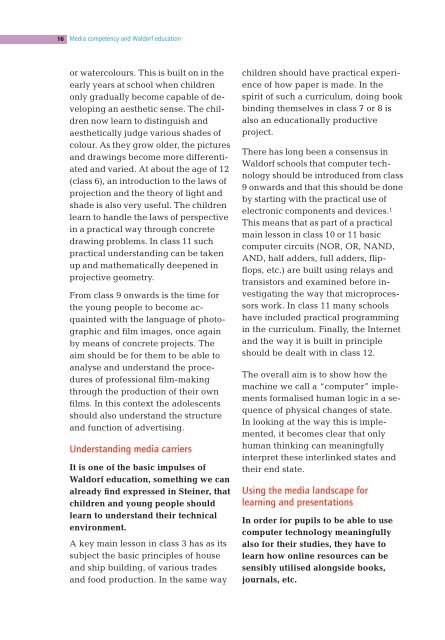Struwwelpeter 2.0
Struwwelpeter_engl_August_2015
Struwwelpeter_engl_August_2015
- No tags were found...
You also want an ePaper? Increase the reach of your titles
YUMPU automatically turns print PDFs into web optimized ePapers that Google loves.
16 Media competency and Waldorf education<br />
or watercolours. This is built on in the<br />
early years at school when children<br />
only gradually become capable of developing<br />
an aesthetic sense. The children<br />
now learn to distinguish and<br />
aesthetically judge various shades of<br />
colour. As they grow older, the pictures<br />
and drawings become more differentiated<br />
and varied. At about the age of 12<br />
(class 6), an introduction to the laws of<br />
projection and the theory of light and<br />
shade is also very useful. The children<br />
learn to handle the laws of perspective<br />
in a practical way through concrete<br />
drawing problems. In class 11 such<br />
practical understanding can be taken<br />
up and mathema tically deepened in<br />
projective geometry.<br />
From class 9 onwards is the time for<br />
the young people to become acquainted<br />
with the language of photographic<br />
and film images, once again<br />
by means of concrete projects. The<br />
aim should be for them to be able to<br />
analyse and understand the procedures<br />
of professional film-making<br />
through the production of their own<br />
films. In this context the adolescents<br />
should also understand the structure<br />
and function of advertising.<br />
Understanding media carriers<br />
It is one of the basic impulses of<br />
Waldorf education, something we can<br />
already find expressed in Steiner, that<br />
children and young people should<br />
learn to understand their technical<br />
environment.<br />
A key main lesson in class 3 has as its<br />
subject the basic principles of house<br />
and ship building, of various trades<br />
and food production. In the same way<br />
children should have practical experience<br />
of how paper is made. In the<br />
spirit of such a curriculum, doing book<br />
binding themselves in class 7 or 8 is<br />
also an educationally productive<br />
project.<br />
There has long been a consensus in<br />
Waldorf schools that computer technology<br />
should be introduced from class<br />
9 onwards and that this should be done<br />
by starting with the practical use of<br />
electronic components and devices. 1<br />
This means that as part of a practical<br />
main lesson in class 10 or 11 basic<br />
computer circuits (NOR, OR, NAND,<br />
AND, half adders, full adders, flipflops,<br />
etc.) are built using relays and<br />
transistors and examined before investigating<br />
the way that microprocessors<br />
work. In class 11 many schools<br />
have included practical programming<br />
in the curriculum. Finally, the Internet<br />
and the way it is built in principle<br />
should be dealt with in class 12.<br />
The overall aim is to show how the<br />
machine we call a “computer” implements<br />
formalised human logic in a sequence<br />
of physical changes of state.<br />
In looking at the way this is implemented,<br />
it becomes clear that only<br />
human thinking can meaningfully<br />
interpret these interlinked states and<br />
their end state.<br />
Using the media landscape for<br />
learning and presentations<br />
In order for pupils to be able to use<br />
computer technology meaningfully<br />
also for their studies, they have to<br />
learn how online resources can be<br />
sensibly utilised alongside books,<br />
journals, etc.


